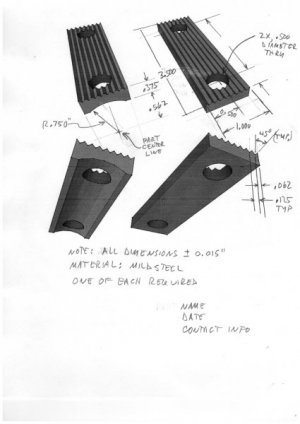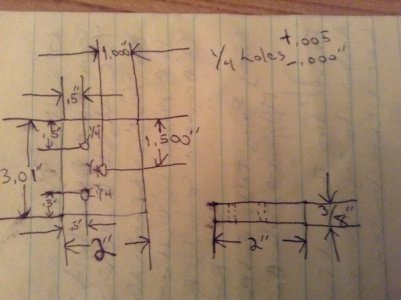I kinda think many of us should lighten up a little bit. Scootered said he was absolutely new to all of this: "Nothing. I have never even seen a machine shop. I have no idea about terminology, technique, or proper practices." Also recall that he said, "My ultimate goal is to find someone who would be willing to make them, without me having to mortgage my house or sell my car to pay for them."
So let's back up a step or two, try to put ourselves in his shoes, and do what we can from there.
Scootered -
OK, Paint Shop Pro isn't a CAD program by any means, but you do seem to have the basic shapes drawn up. Dimensioning will be necessary when you want to show this to a machinist, and it's probably impossible on Paint Shop. But here's a trick I've used a time or two, that may get you where you need to be.
(1) First, you print out your creation. The example I'm doing is a screen shot from your first post. The "perspective" views are good for the overall concept, but if at all possible, you should include "face on" images from the face and the end, maybe even the side.
(2) Pencil in the dimensions, with tolerances. I've added a few (guesses) that I think are consistent with your posts. You need to give enough information to the machinist so he can build it.
Where is each feature (generally with respect to one corner/face or other known feature of the part)? How big is the feature? Etc. A basic mechanical drawing/drafting book might be of use. But don't be intimidated by all the persnickerty details in anything beyond the first chapter or two. Your part is pretty basic.
(3) Scan the marked-up drawing back into your computer. Then you can make as many copies as needed, and have a record of the original.
(4) Take this along when you talk to machinists. Decide ahead of time that the purpose of the first such visit will be more educational than anything else. Let them know that you're not using a real CAD program. Thenlisten to the suggestions that they make. Have a second copy of the drawing in your hand, and make notes on it. Thank them for their time.
(5) Correct your drawing, per the suggestion of the first visit. Then either return to the same machinist, or go to some others.
Having a dimensioned drawing is pretty much vital to the process. As some others have pointed out, the actual machining is
not an interactive process. You give the drawing to the machinist, then go away and wait for him to let you know the part is ready.
Errors?
If the part is not made per the drawing, you can ask for a correction or re-do. If it's per print, you own the result. And again (as we've all done time after time), learn from your mistakes.
Best wishes!




